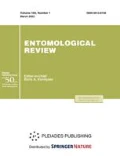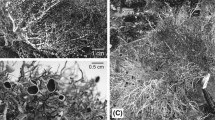Abstract
Trophic relations of lichen-feeding darkling beetles of the tribe Helopini in Turkey, the Caucasus, and Anti-Atlas are considered. This group is the most diverse in relict Anatolian forests of Cedrus libani, Abies cilicica, Pinus nigra, Juniperus spp., and Quercus cerris, where multitaxon lichenophagous assemblages exist. Three life strategies for attenuation of interspecific competition are distinguished: (1) differentiation of the consumed lichens, (2) separation of the life forms based on the types of the lichens consumed, and (3) segregation of circadian activity in adults. We assume that adaptation of the Helopini larvae to the soil life promoted their wide distribution in different landscapes by elimination of the limiting factor for completing their life cycles, namely the need for ligneous substrate of old rotting trees. The possibility of using lichen-feeding beetles of the tribe Helopini in ecosystem and lichen indication is considered.
Similar content being viewed by others
References
Abdurakhmanov, G.M. and Medvedev, G.S., Catalog of Darkling Beetles of the Caucasus (Dagestan State Pedagogical University, Makhachkala, 1994) [in Russian].
Abdurakhmanov, G.M., Nabozhenko, M.V., Abdurakhmanov, A.G., Ivanushenko, Yu.Yu., and Daudova, M.G., “Geographic Relations of Darkling Beetles (Coleoptera: Tenebrionidae) of the Palaearctic Tethys Desert-Steppe Region with the Historical Review,” Yug Rossii: Ekologiya, Razvitie 11 (3), 35–89 (2016).
Aloquio, S. and Lopes-Andrade, C., “Redescription of Immature Stages and Adults of Nilio (Nilio) brunneus (Coleoptera: Tenebrionidae: Nilioninae),” Zoologia 33 (1), e20150191 (2016).
Bagnoli, F., Tsuda, Y., Fineschi, S., Bruschi, P., Magri, D., Zhelev, P., Paule, L., Simeone, M.C., González-Martínez, S.C., and Vendramin, G.G., “Combining Molecular and Fossil Data to Infer Demographic History of Quercus cerris: Insights on European Eastern Glacial Refugia,” Journal of Biogeography 43 (4), 679–690 (2015).
Biltekin, D., Popescu, S.-M., Suc, J.-P., Quézel, P., Jiménez-Moreno, G., Yavuz, N., and Namık Çağatay, M., “Anatolia: a Long-Time Plant Refuge Area Documented by Pollen Records over the Last 23 Million Years,” Review of Palaeobotany and Palynology 215 1–22, (2015).
Brightman, F.H., “Insect on Lichens,” Lichenologist 3 (1), 154 (1965).
Byazrov, L.G., “Invertebrates in Epiphytic Lichens of Different Life Forms in Forests of the Moscow Area,” in Biology of Soils of Middle Europe (Nauka, Moscow, 1988), pp. 149–154 [in Russian].
Byazrov, L.G., Medvedev, L.N., and Chernova, N.M., “Lichen Consortia in Broadleaf-Coniferous Forests of the Moscow Area,” in Biogeocenological Studies in Broadleaf-Spruce Forests (Nauka, Moscow, 1971), pp. 252–270 [in Russian].
Byazrov, L.G., Martynova, E.F., and Medvedev, L.N., “Springtails (Collembola) in Lichen Sinusiae of Khangai, Mongolian People’s Republic,” Byulleten Moskovskogo Obshchestva Ispytatelei Prirody. Otdel Biologicheskii 81 (3), 66–73 (1976).
Byzova, Yu.B. and Gilyarov, M.S., “Soil Dwelling Larvae of Darkling Beetles of the Tribe Helopini (Coleoptera, Tenebrionidae),” Zoologicheskii Zhurnal 35 (10), 1493–1509 (1956).
Chahartaghi, M., Langel, R., Scheu, S., and Ruess, L., “Feeding Guilds in Collembola Based on Nitrogen Stable Isotope Ratios,” Soil Biology & Biochemistry 37 1718–1725, (2005).
Gerson, U., “Lichen-Arthropod Associations,” Lichenologist 5 434–443, (1973).
Gerson, U. and Seaward, M.R.D., “Lichen-Invertebrate Associations,” in Lichen Ecology (Academic Press, London, 1977), pp. 69–119.
Gilyarov, M.S., The Zoological Method of Soil Diagnostics (Nauka, Moscow, 1965) [in Russian].
Kergoat, G.J., Bouchard, P., Clamens, A.-L., Abbate, J.L., Jourdan, H., Jabbour-Zahab, R., Genson, G., Soldati, L., and Condamine, F.L., “Cretaceous Environmental Changes Led to High Extinction Rates in a Hyperdiverse Beetle Family,” BMC Evolutionary Biology 14 1–13, (2014).
Kirejtshuk, A.G., “On the Establishment of Phyllophagy among Beetles (Coleoptera),” Trudy Zoologicheskogo Instituta Akademii Nauk SSSR 202 147–182, (1989).
Kirejtshuk, A.G., Ponomarenko, A.G., Prokin, A.A., Huali, Ch., Nikolajev, G.V., and Dong, R., “Current Knowledge of Mesozoic Coleoptera from Daohugou and Liaoning (Northeast China),” Acta Geologica Sinica 84 (4), 783–792 (2010).
Moskowitz, D.P., “Notes on the Larval Diet of the Painted Lichen Moth Hypoprepia fucosa Hubner (Arctiidae: Lithosiinae),” Journal of the Lepidopterists’ Society 56 (4), 289–290 (2002).
Nabozhenko, M.V., “Landscape-Biotopic Distribution and Trophic Links of Tenebrionid Beetles of the Tribe Helopini (Coleoptera, Tenebrionidae) in the Caucasus and Pre-Caucasus,” in Studies of the Southern Scientific Centre of the Russian Academy of Sciences, Issue 3: Biodiversity and Transformation of Mountain Ecosystems of Caucasus (SSC RAS Publishing, Rostov-on-Don, 2007), pp. 242–252 [in Russian].
Nabozhenko, M.V., “To the Knowledge of Helopini (Coleoptera: Tenebrionidae) of Morocco,” Caucasian Entomological Bulletin 11 (1), 33–37 (2015).
Nabozhenko, M.V. and Keskin, B., “Revision of the Genus Odocnemis Allard, 1876 (Coleoptera: Tenebrionidae: Helopini) from Turkey, the Caucasus and Iran with Observations on Feeding Habits,” Zootaxa 4202 (1), 1–97 (2016).
Nabozhenko, M.V. and Kirejtshuk, A.G., “Cryptohelops menaticus–a New Genus and Species of the Tribe Helopini (Coleoptera: Tenebrionidae) from the Palaeocene of Menat (France),” Comptes Rendus Palevol 13 (2), 65–71 (2014).
Nabozhenko, M.V., Keskin, B., and Alpagut Keskin, N., “Taxonomic Review of the Genus Armenohelops Nabozhenko, 2002 (Coleoptera: Tenebrionidae) with Additional Support of the Mitochondrial COI Gene Sequences,” Caucasian Entomological Bulletin 12 (2): 255–268 (2016a).
Nabozhenko, M.V., Perkovsky, E.E., and Chernei, L.S., “A New Species of the Genus Nalassus Mulsant (Coleoptera: Tenebrionidae: Helopini) from the Baltic Amber,” Paleontological Journal 50 (9), 947–952 (2016b).
Nabozhenko, M.V., Lebedeva, N.V., Nabozhenko, S.V., and Lebedev, V.D., “The Taxocene of Lichen-Feeding Darkling Beetles (Coleoptera, Tenebrionidae: Helopini) in a Forest-Steppe Ecotone,” Entomologicheskoe Obozrenie 95 (1), 137–152 (2016c) [Entomological Review 96 (1), 101–113 (2016c)].
Nabozhenko, M.V., Keskin, B., and Nabozhenko, S.V., “Lichenophagous Tenebrionidae as Indicators of Relict Forests in Anatolia,” in Economic Botany: State and Prospects of Development. Proceedings of the VII International Conference, Donetsk, 17–19 May 2017 (Altair, Rostov-on Don, 2017), pp. 302–306.
Nikitsky, N.B., “Darkling Beetles (Coleoptera: Tenebrionidae) of Moscow Province,” Caucasian Entomological Bulletin 12 (1), 117–130 (2016).
Nikitsky, N.B. and Chernyshev, S.E., “Pill Beetles (Coleoptera, Byrrhidae) of Moscow Province,” Evraziatskii Entomologicheskii Zhurnal 15 (4), 354–359 (2016).
Pöykkö, H., Host Range of Lichenivorous Moths with Special Reference to Nutritional Quality and Chemical Defense in Lichens. Academic Dissertation to Be Presented with the Assent of the Faculty of Science, University of Oulu, for Public Discussion in Kuusamonsali (University of Oulu, Oulu, 2005).
Pöykkö, H. and Hyvärinen, M., “Host Preference and Performance of Lichenivorous Eilema spp. Larvae in Relation to Lichen Secondary Metabolites,” Journal of Animal Ecology 72 383–390, (2003).
Pöykkö, H., Bačkor, M., Bencúrová, E., Molcanová, V., Bačkorová, M., and Hyvärinen, M., “Host Use of a Specialist Lichen-Feeder: Dealing with Lichen Secondary Metabolites,” Oecologia 164 (2), 423–430 (2010).
Purchart, L. and Nabozhenko, M.V., “Description of Larva and Pupa of the Genus Deretus (Coleoptera: Tenebrionidae) with Key to the Larvae of the Tribe Helopini,” Acta Entomologica Musei Nationalis Pragae 52 (Suppl. 2), 295–302 (2012).
Schneider, K., Migge, S., Norton, R.A., Scheu, S., Langel, R., Reineking, A., and Maraun, M., “Trophic Niche Differentiation in Soil Microarthropods (Oribatida, Acari): Evidence from Stable Isotope Ratios (15N/14N),” Soil Biology & Biochemistry 36 1769–1774, (2004).
Seyd, E.L. and Seaward, M.R.D., “The Association of Oribatid Mites with Lichens,” Zoological Journal of the Linnean Society 80 (4), 369–420 (1984).
Stebaev, I.V. and Pivovarova, Zh.F., “The Origin and Development of Biocenoses on Rocks,” Zhurnal Obshchei Biologii 53 (5), 715–729 (1992).
Stebaeva, S.K. and Sedelnikova, N.V., “The Population of Collembola (Hexapoda) in Lichen Consortia of the Sangilen Upland,” Sibirskii Ekologicheskii Zhurnal 5 509–513, (1999).
Stebaeva, S.K., Sedelnikova, N.V., Andrievskii, V.S., and Volonikhina, I.I., “Microarthropod Associations under Lichens in the Eastern Tanu-Ola Range (Tuva),” Zoologicheskii Zhurnal 80 (2), 170–182 (2001).
Striganova, B.R., The Feeding of Soil Saprophages (Nauka, Moscow, 1980) [in Russian].
Tiunov, A.V., “Stable Carbon and Nitrogen Isotopes in Soil Ecology,” Izvestiya Rossiiskoi Akademii Nauk. Seriya Biologicheskaya 4 475–479, (2007).
Wagner, D.L., “The Immature Stages: Structure, Function, Behavior, and Ecology,” in Tiger Moths and Woolly Bears: Behavior, Ecology, and Evolution of the Arctiidae, Ed. by W.E. Conner (Oxford University Press, Oxford, 2009), pp. 31–53.
Wang, B., Zhang, H., and Jarzembowski, E.A., “Early Cretaceous Angiosperms and Beetle Evolution,” Frontiers in Plant Sciences 4 1–6, (2013).
Watt, J.C., “Entomology of the Aucklands and Other Islands South of New Zealand: Coleoptera: Scarabaeidae, Byrrhidae, Ptinidae, Tenebrionidae,” Pacific Insects Monograph 27 193–224, (1971).
Watt, J.C., Fauna of New Zealand. 26: Tenebrionidae (Insecta: Coleoptera): Catalogue of Types and Keys to Taxa (DSIR Plant Protection, Auckland, 1992).
Author information
Authors and Affiliations
Corresponding author
Additional information
Original Russian Text © M.V. Nabozhenko, B. Keskin, S.V. Nabozhenko, 2017, published in Entomologicheskoe Obozrenie, 2017, Vol. 96, No. 3, pp. 436–450.
Rights and permissions
About this article
Cite this article
Nabozhenko, M.V., Keskin, B. & Nabozhenko, S.V. Life forms and strategies of lichen-feeding darkling beetles (Coleoptera, Tenebrionidae: Helopini). Entmol. Rev. 97, 735–746 (2017). https://doi.org/10.1134/S0013873817060045
Received:
Published:
Issue Date:
DOI: https://doi.org/10.1134/S0013873817060045




